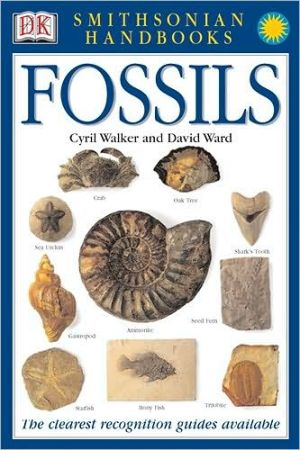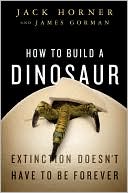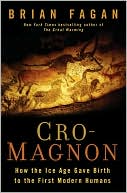The Princeton Field Guide to Dinosaurs
This lavishly illustrated volume is the first authoritative dinosaur book in the style of a field guide. World-renowned dinosaur illustrator and researcher Gregory Paul provides comprehensive visual and textual coverage of the great Mesozoic animals that gave rise to the living dinosaurs, the birds. Incorporating the new discoveries and research that are radically transforming what we know about dinosaurs, this book is distinguished both by its scientific accuracy and the quality and quantity...
Search in google:
"I have been looking forward to this book for years. Gregory Paul has set the standard for how prehistoric animals are reconstructed in scientific illustrations. As with all his work, the illustrations in this book are made with a near-fanatical quest for accuracy. This will be a popular and much-used reference for a wide audience of dinosaur enthusiasts."—James I. Kirkland, state paleontologist, Utah Geological Survey Library Journal This latest book by Paul, a leading dinosaur researcher and illustrator, is an excellent accompaniment to your standard dinosaur encyclopedias. Its strength lies is the inclusion of over 735 species, along with information on how complete the fossil skeletons representing them are, anatomical characteristics, distribution of fossil finds, the animal's probable habitat, and what scientists believe about its behavior. The text incorporates new scientific opinion on the appearance and habitat of many dinosaurs, and it is beautifully illustrated with over 600 images depicting both skeletal anatomy and current opinions on the creatures' appearance. Paul is an expert, having written seven books on dinosaurs as well as many technical papers and popular articles on the subject. VERDICT Though not a field guide to stuff in your backpack, this exciting addition to dinosaur reference is essential for high school through university libraries and is highly recommended for all students of dinosaurs.—Betty Galbraith, Washington State Univ. Libs., Pullman
Preface 6 Acknowledgments 6 Introduction History of Discovery and Research 9 What Is a Dinosaur? 13 Dating Dinosaurs 14 The Evolution of Dinosaurs and Their World 15 Extinction 23 After the Age of Dinosaurs 24 Biology 24 General Anatomy 24 Skin, Feathers, and Color 32 Respiration and Circulation 33 Digestive Tracts 35 Senses 36 Vocalization 37 Disease and Pathologies 37 Behavior 38 Brains, Nerves, and Intelligence 38 Social Activities 38 Reproduction 39 Growth 44 Energetics 46 Gigantism 48 Mesozoic Oxygen 51 The Evolution—and Loss—of Avian Flight 52 Dinosaur Safari 53 If Dinosaurs Survived 54 Dinosaur Conservation 54 Where Dinosaurs Are Found 55 Using the Group and Species Descriptions 61 Group and Species Accounts Dinosaurs 67 Theropods 67 Sauropodomorphs 162 Ornithischians 214 Additional Reading 316 Index: Dinosaur Taxa 317 Formations 319
\ Natural HistoryYou'll never need to decide whether that massive beast lumbering through your front yard is Chasmosaurus belli or C. sternbergi, but if you did, this would be a handy book to have on your windowsill. . . . [A]s dinosaur guidebooks go, this is as carefully assembled and authoritative as they come.\ — Laurence A. Marschall\ \ \ \ \ Scientific AmericanArtist and researcher Gregory S. Paul describes hundreds of dinosaur species in this richly illustrated compendium. Learn how beasts ranging from Allosaurus to zuniceratops grew, moved and reproduced—and how they eventually went extinct.\ \ \ SmithsonianMag.com's Dinosaur Tracking blogGiven the vibrant state of dinosaur science, any book about them is going to be out-of-date by the time it hits shelves, but Gregory Paul's new The Princeton Field Guide to Dinosaurs is a useful yearbook of dinosaurs which includes a variety of rarely-mentioned species. . . . Indeed, Paul is to be credited for pulling so much information together into one volume, as well as for illustrating so many skeletons (some dinosaurs no doubt discovered while the book was in press.)\ — Brian Switek\ \ \ \ \ AudubonMagazine.org blogThe publication of Gregory Paul's The Princeton Field Guide to Dinosaurs is cause for celebration for all who share a fascination with this diverse family of animals. Paul's field guide is (perhaps) the most comprehensive one-volume guide to what we know about 735 species of dinosaurs. The book includes an outstanding . . . introduction summarizing the history of dinosaurs research, evolution, biology, energetics, behavior, and distribution. It includes a discussion of the most arresting feature of dinosaurs—their great size. . . . The heart of the book is a richly illustrated field guide which is organized like any of the field guides that we have become accustomed to. The species are presented in phylogenic order and meticulously and beautifully illustrated following the current state of our knowledge of posture and shape.\ — Wayne Mones\ \ \ \ \ Prehistoric TimesWorld-renowned dinosaur illustrator and researcher Gregory Paul provides comprehensive visual and textual coverage of the dinosaurs in this lavishly illustrated field guide. Incorporating the latest discoveries and research that are radically transforming what we know about dinosaurs, this book is distinguished both by its scientific accuracy and the quality and quantity of its illustrations. . . . The Princeton Field Guide to Dinosaurs is a must-have for anyone who loves dinosaurs, from the amateur enthusiast to the professional paleontologist.\ \ \ \ \ USA TodayLavishly filled with fossil forms and drawn interpretations of their outward appearance, the guide covers the entire spectrum of dinosaur species. The color images of some of the rock stars of the Age of Dinosaurs, from T-Rex to Triceratops, will enthrall any youngster with a yen for these ancient beasts. . . . Paul has revitalized and re-invented the depiction of dinosaurs in recent decades, and the book brings the breadth of their lost world to today's readers.\ — Dan Vergano\ \ \ \ \ Portland Press HeraldA fantastic new book on dinosaurs. . . . Paul is an accomplished illustrator and expert in all things dinosaurian. The first 60 pages of the book provide an introduction to dinosaur biology, morphology and techniques for studying these fossils. The information on how the limbs of dinosaurs articulated is particularly intriguing. . . . His fine illustrations provide nice accents to the text. The meat of the book is the coverage of individual dinosaur species.\ — Herb Wilson\ \ \ \ \ Blogcritics.orgThis book . . . shows off Paul at his artistic and conceptual finest, as it is replete with all the latest knowledge of dinosaurian knowledge. . . . [I]t's an excellent book, one of the best ever, and one which I wish was around in my youth, when all I had were dense textbooks.\ — Dan Schneider\ \ \ \ \ Wired.com's GeekDad blogThere's no doubt that Paul has done a tremendous job with The Princeton Field Guide to Dinosaurs and it's quite impressive. If you're serious about dinosaurs and want a meticulously researched guide, this is certainly the book for you.\ — Jonathan Liu\ \ \ \ \ ChoicePaul, an eminent authority on dinosaur anatomy and a leading dinosaur illustrator, presents detailed information on all dinosaur groups. . . . The author, well known for his detailed skeletal diagrams and ability to interpret dinosaur biomechanics, displays his formidable skills throughout this book. . . . Serious dinosaur scholars will devour this book; it is a major contribution to the field.\ \ \ \ \ American PaleontologistReproduced and copied time and again, Paul's interpretation of dinosaur anatomy has found for years a permanent home on both the popular and scientific page. Paul's latest publication, The Princeton Field Guide to Dinosaurs, is the collection of these skeletal reconstructions that the dinosaur-loving community has been waiting for. If nothing else, it is this collection that makes the book worthy of ownership.\ — Richard A. Kissel\ \ \ \ \ Quarterly Review of BiologyI thoroughly enjoyed this book. It represents the most comprehensive collection of scientifically informed dinosaur anatomical illustrations to date, making it a valuable desk reference. One can imagine taking a trip back to the Mesozoic and using this guide to identify these awe-inspiring creatures. This volume should find a proud place on the bookshelf of both amateurs and professionals.\ — Christopher R. Noto\ \ \ \ \ South Dakota Bird NotesI am certain that all ages of dinosaur fans will love this book.\ — Dan Tallman\ \ \ \ \ Natural HistoryYou'll never need to decide whether that massive beast lumbering through your front yard is Chasmosaurus belli or C. sternbergi, but if you did, this would be a handy book to have on your windowsill. . . . [A]s dinosaur guidebooks go, this is as carefully assembled and authoritative as they come.\ \ \ \ \ SmithsonianMag.com's Dinosaur Tracking blogGiven the vibrant state of dinosaur science, any book about them is going to be out-of-date by the time it hits shelves, but Gregory Paul's new The Princeton Field Guide to Dinosaurs is a useful yearbook of dinosaurs which includes a variety of rarely-mentioned species. . . . Indeed, Paul is to be credited for pulling so much information together into one volume, as well as for illustrating so many skeletons (some dinosaurs no doubt discovered while the book was in press.)\ \ \ \ \ AudubonMagazine.org blogThe publication of Gregory Paul's The Princeton Field Guide to Dinosaurs is cause for celebration for all who share a fascination with this diverse family of animals. Paul's field guide is (perhaps) the most comprehensive one-volume guide to what we know about 735 species of dinosaurs. The book includes an outstanding . . . introduction summarizing the history of dinosaurs research, evolution, biology, energetics, behavior, and distribution. It includes a discussion of the most arresting feature of dinosaurs—their great size. . . . The heart of the book is a richly illustrated field guide which is organized like any of the field guides that we have become accustomed to. The species are presented in phylogenic order and meticulously and beautifully illustrated following the current state of our knowledge of posture and shape.\ \ \ \ \ USA TodayLavishly filled with fossil forms and drawn interpretations of their outward appearance, the guide covers the entire spectrum of dinosaur species. The color images of some of the rock stars of the Age of Dinosaurs, from T-Rex to Triceratops, will enthrall any youngster with a yen for these ancient beasts. . . . Paul has revitalized and re-invented the depiction of dinosaurs in recent decades, and the book brings the breadth of their lost world to today's readers.\ \ \ \ \ Portland Press HeraldA fantastic new book on dinosaurs. . . . Paul is an accomplished illustrator and expert in all things dinosaurian. The first 60 pages of the book provide an introduction to dinosaur biology, morphology and techniques for studying these fossils. The information on how the limbs of dinosaurs articulated is particularly intriguing. . . . His fine illustrations provide nice accents to the text. The meat of the book is the coverage of individual dinosaur species.\ \ \ \ \ Blogcritics.orgThis book . . . shows off Paul at his artistic and conceptual finest, as it is replete with all the latest knowledge of dinosaurian knowledge. . . . [I]t's an excellent book, one of the best ever, and one which I wish was around in my youth, when all I had were dense textbooks.\ \ \ \ \ Wired.com's GeekDad blogThere's no doubt that Paul has done a tremendous job with The Princeton Field Guide to Dinosaurs and it's quite impressive. If you're serious about dinosaurs and want a meticulously researched guide, this is certainly the book for you.\ \ \ \ \ American PaleontologistReproduced and copied time and again, Paul's interpretation of dinosaur anatomy has found for years a permanent home on both the popular and scientific page. Paul's latest publication, The Princeton Field Guide to Dinosaurs, is the collection of these skeletal reconstructions that the dinosaur-loving community has been waiting for. If nothing else, it is this collection that makes the book worthy of ownership.\ \ \ \ \ Quarterly Review of BiologyI thoroughly enjoyed this book. It represents the most comprehensive collection of scientifically informed dinosaur anatomical illustrations to date, making it a valuable desk reference. One can imagine taking a trip back to the Mesozoic and using this guide to identify these awe-inspiring creatures. This volume should find a proud place on the bookshelf of both amateurs and professionals.\ \ \ \ \ South Dakota Bird NotesI am certain that all ages of dinosaur fans will love this book.\ \ \ \ \ ScientificAmerican.com's "Tetrapod Zoology ren Naish\ Greg Paul is an independent researcher who specialises on dinosaurs; he's well known for his popular articles, books and technical papers, but in particular for his hugely influential artwork. Paul's most recent book--the 2010 The Princeton Field Guide to Dinosaurs--is, simply put, the ultimate Greg Paul book. It's a large, heavily illustrated catalogue of over 400 reconstructed skeletons, accompanied throughout with life restorations and brief chunks of text that present data on the world's Mesozoic dinosaur species.\ \ \ \ \ Scientific AmericanArtist and researcher Gregory S. Paul describes hundreds of dinosaur species in this richly illustrated compendium. Learn how beasts ranging from Allosaurus to zuniceratops grew, moved and reproduced—and how they eventually went extinct.\ \ \ \ \ Prehistoric TimesWorld-renowned dinosaur illustrator and researcher Gregory Paul provides comprehensive visual and textual coverage of the dinosaurs in this lavishly illustrated field guide. Incorporating the latest discoveries and research that are radically transforming what we know about dinosaurs, this book is distinguished both by its scientific accuracy and the quality and quantity of its illustrations. . . . The Princeton Field Guide to Dinosaurs is a must-have for anyone who loves dinosaurs, from the amateur enthusiast to the professional paleontologist.\ \ \ \ \ Library JournalThis latest book by Paul, a leading dinosaur researcher and illustrator, is an excellent accompaniment to your standard dinosaur encyclopedias. Its strength lies is the inclusion of over 735 species, along with information on how complete the fossil skeletons representing them are, anatomical characteristics, distribution of fossil finds, the animal's probable habitat, and what scientists believe about its behavior. The text incorporates new scientific opinion on the appearance and habitat of many dinosaurs, and it is beautifully illustrated with over 600 images depicting both skeletal anatomy and current opinions on the creatures' appearance. Paul is an expert, having written seven books on dinosaurs as well as many technical papers and popular articles on the subject. VERDICT Though not a field guide to stuff in your backpack, this exciting addition to dinosaur reference is essential for high school through university libraries and is highly recommended for all students of dinosaurs.—Betty Galbraith, Washington State Univ. Libs., Pullman\ \







